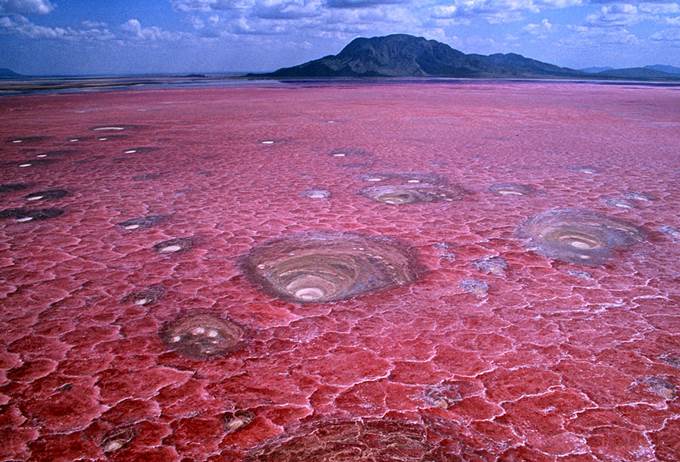
The surrounding bedrock is composed of alkaline, sodium-dominated trachyte lavas that were laid down during the Pleistocene period. The alkalinity of the lake can reach a pH of greater than 12. High levels of evaporation have left behind natron (sodium carbonate decahydrate) and trona (sodium sesquicarbonate dihydrate). Temperatures at the lake are frequently above 40 ☌ (104 ☏).

The surrounding area receives irregular seasonal rainfall, mainly between December and May totalling 800 millimetres (31 in) per year. The lake is a maximum of 57 kilometres (35 mi) long and 22 kilometres (14 mi) wide. It is quite shallow, less than three metres (9.8 ft) deep, and varies in width depending on its water level. The lake is fed principally by the Southern Ewaso Ng'iro River, which rises in central Kenya, and by mineral-rich hot springs.

The lake is within the Lake Natron Basin, a Ramsar Site wetland of international significance. It is in the Gregory Rift, which is the eastern branch of the East African Rift. 3/calcified-animals_n_4032659.Lake Natron is a salt or alkaline lake located in north Ngorongoro District of Arusha Region in Tanzania. See more about these natural mummies here:

of up to 10, and leaves remains of naturally occurring mummies. Salt Alkali lakes like those of Ancient Egypt still exist, as in Tanzania's Lake Natron, whose salt alkali content creates an extreme environment with a ph. Due to its volatility pure sodium was not isolated until 1807, distinguishing it from the natron that it was first named after. The Natrum was the agent used to desiccate organs and tissues so that they would be preserved.

Here was a type of naturally occurring salt, sodium, carbonate, and sodium bicarbonate that was utilized in the art of mummification for which Egyptians were famous. This name hails back to ancient Egyptians, who mined a substance called Natrum from the Wadi El Natrum, the Natrum Valley region of Eastern Egypt. This is the abbreviated from the Natrium, an older name for sodium. On the periodic table Sodium is the 11th element and its symbol is Na. Salt (NaCI) mixed with water makes a solution much like seawater, where elemental sodium (Na) mixed with water, as seen above, creates an extreme reaction. Though abundant, in its natural form sodium is highly reactive making it unstable as a solitary element. In fact, table salt, otherwise known as Sodium Chloride, (NaCI) contains near 40% sodium, but pure sodium is rarely found alone. For most people the word sodium brings to mind the ubiquitous white crystalline agent used for flavoring foods.


 0 kommentar(er)
0 kommentar(er)
